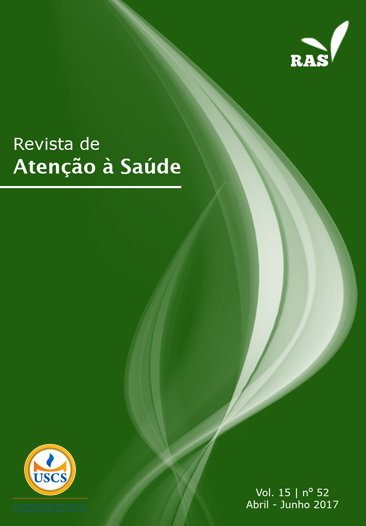Clinical and epidemiological profile of acute chagas disease in the state of Minas Gerais, Brazil
DOI:
https://doi.org/10.13037/ras.vol15n52.4523Keywords:
Chagas disease, Epidemiology, Health information systems, Notification of diseasesAbstract
Introduction: The state of Minas Gerais, Brazil, presents very significant numbers of Chagas endemic disease, and although attempts to control it show positive results, there are still a substantial number of cases in several regions of Minas Gerais. Objective: To know the clinical and epidemiological aspects of acute Chagas disease in the state of Minas Gerais. Methodology: This is a descriptive and documental study, with quantitative approach, based on Minas Gerais. Data were collected in the Brazilian Ministry of Health’s Notifiable Diseases Information System (SINAN), considering the number of cases reported in the period from 2001 to 2006. Notification forms were used when there was suspicion of one of the compulsory notification diseases, as well as Chagas disease acute investigation forms. The main variables obtained were: health macroregion, area of residence, mode of infection and evolution of the case. Results: Between the years of 2001 and 2006, 84 cases of acute Chagas disease were recorded in Minas Gerais. The region with the highest number of cases was the western region, followed by the northern. The majority of individuals were urban residents. The main mode of transmission was by vector, and most cases evolved to remission of clinical manifestations. Conclusion: Knowing the clinical and epidemiological aspects of Chagas disease and spreading the findings will allow the elaboration and implementation of strategies to fight the disease chronification.
Downloads
References
World Health Organization. Chagas disease in Latin
America: an epidemiological update based on 2010 estimates.
Wkly Epidemiol Rec. 2015;90(6):33-44.
Valverde R. Doenças negligenciadas [Internet]. Rio de
Janeiro: Fiocruz; 2013 [citado em 2017 jan 23]. Disponível
Mandal S. Epidemiological Aspects of Chagas Disease: a review.
J Anc Dis Prev Rem. 2014;2(2):117-23.
Oliveira FAZ, Bicalho GVC, Souza Filho LD, Silva MJ,
Gomes Filho ZC. Características epidemiológicas dos
pacientes com doença de Chagas. Rev Bras Med Fam
Comunidade. 2006;6:107-13.
Cesarino RAS, Cesarino MC, Morraye MA. O perfil,
as concepções e percepções dos portadores de doença de
Chagas em unidades de saúde da família. Investigação.
;10(Supl 2):S43-9.
Silva JP. Doença de chagas e seus mecanismos alternativos de
transmissão [monografia]. São Paulo: Centro Universitário
das Faculdades Metropolitanas Unidas; 2007.
Dias JCP. Globalização, iniquidade e doença de Chagas.
Cad de Saúde Públ. 2007;23(Supl l):S13-22.
Silva EM, Paixão GC, Rocha MOC, Silva RC. Estudo clínico-
epidemiológico da doença de Chagas no distrito de
Serra Azul, Mateus Leme, centro-oeste do estado de Minas
Gerais. Rev Soc Bras Med Trop. 2010;43(2):178-81.
Días JCP, Amato Neto V, Albuquerque Luna JE.
Mecanismos alternativos de transmissão do Trypanosoma
cruzi no Brasil e sugestões para sua prevenção. Rev Soc Bras
Med Trop 2011;44(3):375-9.
Araújo SMM. Doença de chagas. News: Artigos CETRUS
[Internet]. 2014 [citado em 2017 jan 22];52:1-19.
Disponível em: https://goo.gl/ftG8PO
Instituto Brasileiro de Geografia e Estatística [homepage
na Internet]. Estimativas populacionais para os municípios
brasileiros [citado em 2017 jan 22]. Disponível em: https://
goo.gl/HjKUBE
Brasil. Ministério da Saúde. Secretaria de Vigilância em
Saúde. Departamento de Vigilância Epidemiológica.
Sistema de Informação de Agravos de Notificação – Sinan:
normas e rotinas. Brasília, DF: Ministério da Saúde; 2006.
Carneiro Filho NVC, Lima SC. Distribuição da doença
de chagas em Minas Gerais, 1998-2007. Anais do VIII
Encontro Interno e Seminário de Iniciação Científica
da Universidade Federal de Uberlândia; 2008 8-9 Out;
Uberlândia, Brasil. Uberlândia: UFU.
Lima AFR. Análise socioambiental da dinâmica da Doença
de chagas no estado de Sergipe/Brasil, 2001-2009 [dissertação].
Aracajú: Universidade Tiradentes; 2010.
Silva HC, Galdame AMA, Bastos CJC, Grassi MFR, Silva
M, Silveira M, et al. Avaliação clínica na atenção primária e
infectologia dos pacientes com doença de chagas na forma
crônica. Rev Baiana Saúde Pública. 2013;37(Supl 1):7-21.
Pinto AY, Valente SA, Valente VC, Ferreira Junior AG,
Coura JR. Acute phase of Chagas disease in the Brazilian
Amazon region: study of 233 cases from Para, Amapá and
Maranhão observed between 1988 and 2005. Rev Soc Bras
Med Trop. 2008;41(6):602-14.
Alves RMA, Thomaz RP, Almeida EA, Silva J, Wanderley
JS, Guariento ME. Chagas’ disease and ageing: the coexistence
of other chronic diseases with Chagas’ disease in elderly
patients. Rev Soc Bras Med Trop. 2009;42(6):622-8.
Dias JCP, Ramos Júnior AN, Gontijo ED, Luquetti
A, Shikanai-Yasuda MA, Coura JR, et al. II Consenso
Brasileiro em Doença de Chagas, 2015. Epidemiol Serv
Saude. 2016;25(n. esp.):7-86.
Gontijo ED, Santos SE. Mecanismos principais e atípicos
de transmissão da doença de Chagas. Fiocruz. Ministério da
Saúde [Internet]. 2009 [citado em 2014 out 29]. Disponível
Brasil. Ministério da Saúde. Fundação Nacional da Saúde.
Centro Nacional de Epidemiologia. Doenças infecciosas e
parasitárias, aspectos clínicos vigilância epidemiológica e medidas
de controle. Brasília, DF: Ministério da Saúde; 2000.
Pereira BI, Nazareth C, Malcata L, Alves H, Fernandez JR,
Sargento C, et al. Transfusion-transmitted protozoal infections:
what is the risk in non-endemic countries? Acta Med
Port. 2011;24:897-906.
Moraes-Souza H, Ferreira-Silva MM. O controle da transmissão
transfusional. Rev Soc Bras Med Trop. 2011;44(Sup
:64-7.
Silva VLC, Luna EJA. Prevalência de infecção pelo T. cruzi
em doadores de sangue nos hemocentros coordenadores do
Brasil em 2007. Epidemiol Serv Saúde. 2013;22(1):103-10.
Muguande OF, Ferraz ML, França E, Gontijo ED. Avaliação
da qualidade do sistema de vigilância epidemiológica de
Doença de Chagas Aguda em Minas Gerais. Epidemiol Serv
Saúde. 2011;20(3):317-25.
Downloads
Published
Issue
Section
License
Policy Proposal for Journals offering Free Delayed Access
Authors who publish in this magazine agree to the following terms:
- Authors maintain the copyright and grant the journal the right to the first publication, with the work simultaneously licensed under a Creative Commons Attribution License after publication, allowing the sharing of the work with recognition of the authorship of the work and initial publication in this journal.
- Authors are authorized to assume additional contracts separately, for non-exclusive distribution of the version of the work published in this magazine (eg, publishing in institutional repository or as a book chapter), with the acknowledgment of the authorship and initial publication in this journal.
- Authors are allowed and encouraged to publish and distribute their work online (eg in institutional repositories or on their personal page) at any point before or during the editorial process, as this can generate productive changes, as well as increase impact and citation of the published work (See The Effect of Open Access).









